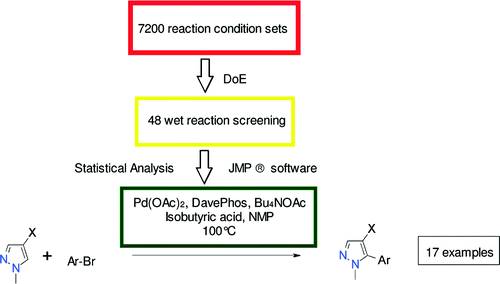Regioselective Palladium-Catalyzed Arylation of 4-Chloropyrazoles
A very nice demonstration of the DOE usefulness in drug discovery.
Our readers will remember that Design of Experiments (DOE) is a recurrent topic in our newsletter. For a long time we have advocated the use of DOE not only in the development phases of the project, that is, once a candidate has been chosen, but also during the early stages of the drug discovery process, when chemists are in the need of better conditions to prepare scaffolds or specific substitution patterns. Very soon we will be publishing around an article following these lines, and the first paper selected for our Top Five is one of the nicest examples we have seen lately. As added note, one of the authors worked in GalChimia some years ago and we are very happy to see his excellent work.
Mateos et al. (Eli Lilly, Madrid, Spain) have published a demonstration of how useful and powerful DOE is when done properly. In connection with a drug discovery programme, they required a methodology to access 5-aryl-1-methyl-pyrazoles quickly. That is, they needed not the best yield, but a method delivering the desired isomer. The reaction under study was a metal-catalyzed arylation of 4-chloropyrazole. Those skilled in the state of the art of C-H activation know that five factors are critical, so they were to be studied: solvent, base, catalyst, ligand and additive. For these factors the authors, according to their previous expertise and the information available in the literature, contemplated six, ten, four, six and five possibilities respectively. To explore each set of reaction parameters a total of 7,200 experiments would have to be done. That is indeed a big number!
However, with DOE and statistical software, the number of experiments was reduced to 48, and even with so few experiments the statistical analysis renders useful information. JMP by SAS was used in this instance but many other valid statistical packages are available, such as MODDE by Umetrics and DesignExpert by StatEase.
Although some people might argue (and they have done it) that the final conditions are not so different to the solution they would have provided under the current knowledge for these C-H activations, there are several points that must be emphasised. Firstly, DOE offered a rational, organised approach to the problem. In addition, the experiments done and the subsequent analysis show not only that Bu4NOAc is the best base but also that the other four factors are of low relevance to the outcome of the reaction. Finally, the analysis predicted two different sets of conditions that were not previously performed in the 48 reaction set. So there you are: from hints to a functional reaction conditions set in only 48 experiments. Not bad at all.
Org. Lett., 2010, 12 (21), pp 4924–4927. See: 10.1021/ol1020898

